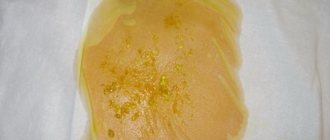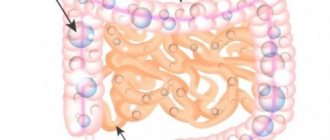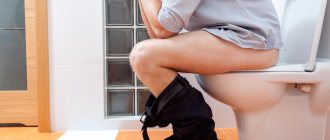The condition of stool in adults and children is an indicator of changes in health. Color, consistency, smell can indicate various types of pathologies. Constipation and diarrhea are symptoms of diseases of the digestive system and other organs. Before starting therapy, it is important to understand what exactly caused the changes, why diarrhea with foam appears in an adult or intestinal obstruction. This is the only way to select adequate therapy and get rid of the problem.
Causes of foamy stool and main symptoms
If, during bowel movements, the stool changes consistency, bubbles appear on the surface of the liquid stool, that is, foamy stool appears, to eliminate the problem, you should understand that there are a number of reasons that can cause foamy stool in an adult, and the condition is accompanied by a number of symptoms.
Dysbacteriosis is one of the most common causes of foamy stools. In this case, loose stools with foam indicate an imbalance in the intestinal microflora. Against the background of suppressed immunity, due to taking medications or suffering from an illness, conditionally pathogenic microflora begins to suppress the beneficial ones.
In this case, in addition to foam in the stool, the following is added to the symptom:
- Rumbling.
- Attacks of nausea, vomiting.
- Foul odor from the mouth.
- Spasm in the peritoneum.
- Flatulence.
An intestinal infection also changes the color of the stool, the stool becomes intensely yellow with foamy formations on the surface. This type of infection is often the cause of non-compliance with hygiene rules - the result of the vital activity of pathogenic microflora (enterovirus, rotavirus, salmonella).
With this disease, foamy diarrhea in an adult is accompanied by a group of additional disorders:
- Hyperthermia.
- Abdominal pain.
- Vomiting, nausea.
Violation of the diet provokes short-term discomfort due to the consumption of unusual foods in exotic countries, oversaturation, abuse of fibrous and excessively fatty foods. Also, the appearance of diarrhea with foam is the result of drinking alcohol in large quantities. In this case, there may be no pronounced symptoms.
In case of lactose deficiency, celiac disease, individual intolerance to certain foods, diarrhea with foam is accompanied by:
- Loss of strength.
- Flatulence, severe bloating.
- Attacks of vomiting and nausea.
- Immune response to an allergen.
Chronic pathologies of the digestive system (gastritis, peptic ulcers, enterocolitis) often cause foamy diarrhea. Diseases are aggravated by a decrease in the barrier functions of the body and spring vitamin deficiency.
Characteristic symptoms:
- White foam on the stool and they also cover the anus of the butt.
- Pain syndrome in the abdomen.
Helminthic infestation - diarrhea when the body is infected with helminths - is the body's response indicating the presence of parasites. If an adult's loose stool becomes foamy, the symptom indicates active vital activity and large accumulations of worms.
What does diarrhea mean?
Mild intestinal disorders that cause diarrhea do not threaten human life; it is another matter when diarrhea is accompanied by:
- dehydration;
- heat;
- weakness, dizziness;
- foamy diarrhea.
These are already reasons to consult a doctor, because they indicate pathological problems in the body.
With proper metabolism and functioning of the gastrointestinal tract, a person has no problems with defecation: feces are formed, do not have a special odor, and their color may vary. With diarrhea with foam, gas bubbles are observed in the stool, the color of the stool becomes light, even white, and they have an unpleasant sour odor.
This process may be accompanied by painful sensations in the abdomen, rumbling, and increased gas formation.
Important! If at the same time a child or an adult shows signs of general malaise, fever, weakness, these are indicators of infection.
Diagnostic methods for identifying the cause of diarrhea
If a patient is admitted to the hospital with a symptom based on foamy diarrhea, the doctor must conduct a thorough examination, palpate the peritoneum, listen to complaints, review the medical history, and find out the presence of concomitant ailments. The diagnosis is made after additional research, during which the patient is limited in communication with others.
The doctor must prescribe:
- bacteriology of feces;
- coprogram;
- general examinations of blood, urine, feces;
- irrigation or colonoscopy;
- sigmoidoscopy;
- X-ray with contrast;
- ultrasonography;
- if the doctor considers it appropriate - CT, MRI;
- breathing, stress tests.
Only a gastroenterologist can make a diagnosis and develop a treatment regimen for the disease, taking into account the characteristics of the course of a particular patient. Here, not only liquid, foamy stool is the focus of the specialist’s assessment, but all other signs of disruption of the body’s functioning.
Injury
Trauma to the intestine or other internal organ causes damage to its walls. Bleeding of varying intensity occurs. Blood in the stool can be found after a bruise to the soft tissue of the intestines or stomach. Timely medical assistance in treating the injury will stop the bleeding. In case of injury, it is better to remain calm and follow all medical instructions.
If the causes of diarrhea with blood in an adult are quite dangerous, then the patient should undergo treatment in a hospital. The patient is given intravenous infusions of prescribed medications and saline solutions, and intramuscular injections are given.
When diarrhea with blood in an adult, the cause of which has not been identified, you can feel burning and itching in the posterior canal, as well as pain of varying intensity. It is important to undergo medical diagnostics to determine the exact cause of the development of a dangerous symptom.
When emergency help is needed
In cases where the disease progresses rapidly and the patient’s condition sharply worsens, this is a reason to immediately consult a doctor.
In addition, the following symptoms indicate that specialist intervention is required:
- Hard abdomen with signs of intense bloating. In this case, pressing the peritoneum with your fingers provokes the appearance of severe pain. At the same time, there is foam in the stool.
- The stool is green and there are blood clots in the stool.
- Hyperthermia above 38 degrees.
- Diarrhea continues for a long time and no improvement is expected.
This course indicates that this is a symptom of a serious pathology and therapy cannot be delayed. The causes of this condition can be very diverse, so it is recommended to consult a doctor before starting treatment. When a person poops foam, he needs attention and careful monitoring so that the condition does not worsen dramatically.
Ulcer
Ulcerative damage to the mucous membrane of the digestive organ provokes the development of bleeding. For peptic ulcers, it is important to use medications for exacerbation. The ulcer is often accompanied by black, loose stools.
Once an ulcer is detected, treatment for diarrhea includes diet and medications to heal the ulcer. The action of the medications used should be aimed at stopping bleeding or bleeding.
Diarrhea with blood and mucus causes dangerous disturbances in the body and severe dehydration. Large fluid loss can lead to seizures and other dangerous consequences. It is important to take food and water in small, frequent portions. Fenyuls, Ferrum-lek, Maltofer will help increase hemoglobin in the blood.
Treatment of the disorder
Foamy stools are not always a reason to run to the hospital. If the patient’s condition is stable, the urge to defecate infrequently (4 times a day), and minor manifestations of discomfort, attempts are made to cope with the problem on their own.
If foam in the stool does not go away more often, adhere to the following algorithm of actions:
- To exclude the possibility of dehydration, use Regidron diluted in a liter of water.
- Take sorbents to eliminate intoxication (Smecta, Enterosgel, Atoxil). The drugs have an astringent effect, have antimicrobial properties, and accelerate regeneration processes. Once in the intestines, they envelop the walls, eliminate the inflammatory process, and prevent injuries.
- You can take Imodium once to restore peristalsis.
- After stopping diarrhea, it is recommended to take probiotics (Linex, Bifidumbacterin) to restore normal microflora.
Important! To get rid of a bothersome symptom, it is necessary to eliminate the cause that provoked its appearance. Doctors use conservative methods of therapy, prescribe medications and diet. In some cases, non-traditional treatment methods have a good effect.
How to treat diarrhea with foam
Liquid diarrhea can be treated at home with folk remedies or seek medical help. The decision will depend on the cause and progression of the symptoms of the disease.
Traditional treatment is usually carried out in a comprehensive manner:
- usually therapy begins with an enema and intestinal lavage;
- then drug treatment for adults involves taking drugs orally or by intravenous and intramuscular injections. In especially severe cases, they resort to the use of droppers for infusion therapy;
- patients in the hospital are prescribed a strict gentle diet, which will help restore the gastrointestinal tract and normal intestinal microflora, and normalize stool. Most often, for this case, a diet of rice cooked without salt and fat, rye bread and bananas is used. In addition, a sick person will usually have to drink a lot of fluids with the addition of saline solutions, for example, Regidron, for several days.
Drug therapy
Naturally, it is necessary to eliminate the cause of diarrhea, but first of all you should get rid of the symptoms, since the risk of dehydration is high. All medications and concomitant treatments are prescribed only by a doctor, and if his instructions are strictly followed, foamy diarrhea quickly passes and a complete recovery occurs.
But you should start therapy immediately:
Depending on the cause, antibiotics or cephalosporins are prescribed. The selection of medications is carried out by a doctor;- Loperamide and Imodium - help reduce intestinal motility and stop diarrhea;
- Restoration of microflora is carried out using Linex, Bifidumbacterin, Bififor;
- To remove toxins, Smecta, Enterosgel, Atoxil are prescribed;
- Replacement therapy is carried out to ensure the supply of enzymes. Recommended drugs - Pancreatin, Festal, Panzinorm.
Diet for foamy stools
Treatment of liquid foamy diarrhea at home in adults begins with establishing proper nutrition, which allows normalization of the formation of feces:
- First of all, it is recommended to immediately introduce the correct diet and strictly adhere to it. The diet should include foods low in fiber and fatty carbohydrates, and a minimum of dairy products;
- After some time, the composition of the diet should become more balanced and healthy by adding vitamins, micro- and macroelements to the diet, the correct ratio of carbohydrates, proteins, fats;
- During treatment, you must remember to drink plenty of fluids - at least two liters per day;
- If foamy stool occurs sporadically and lasts a short time, the problem can be solved without medical intervention. It is enough to take a few tablets of activated carbon, wash it down well with water and fast for a while (12-24 hours).
Diet
Nutrition should be correct, balanced, healthy. If you are prone to diarrhea, it is recommended to adhere to the diet of treatment table No. 4. Foods that can cause irritation of the digestive system are eliminated from the usual diet. Meals should be fractional, five times a day.
Food is eaten warm. It is preferable to chop the dishes finely and crush them using a blender. Food is prepared mainly using gentle methods (boiled, stewed, steamed). It is important to maintain a drinking regime. The daily intake of water should be at least 1.5 liters.
It is worth excluding completely: bread, buns, sausages, pasta, mayonnaise, store-bought sauces, beer, chocolate, canned food.
Oncology
Blood from the anus is often observed with tumors of the digestive organs. The higher the tumor is located, the darker the stool will be. Bloody discharge from a tumor is often found on the surface of the stool. Often blood in stool can be seen in cases of intestinal and stomach cancer.
Oncology requires special specific treatment. When diarrhea becomes the norm with a malignant tumor, it is necessary to direct therapy to eliminate anemia and take iron-containing drugs. Surgery can help eliminate a malignant tumor.











